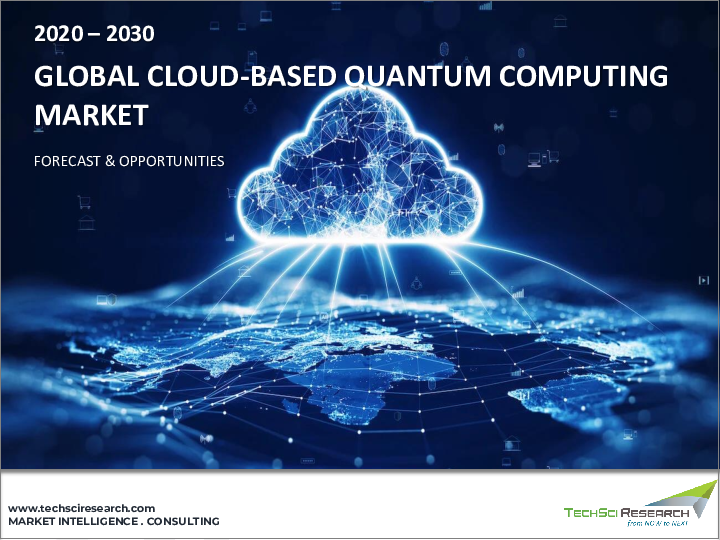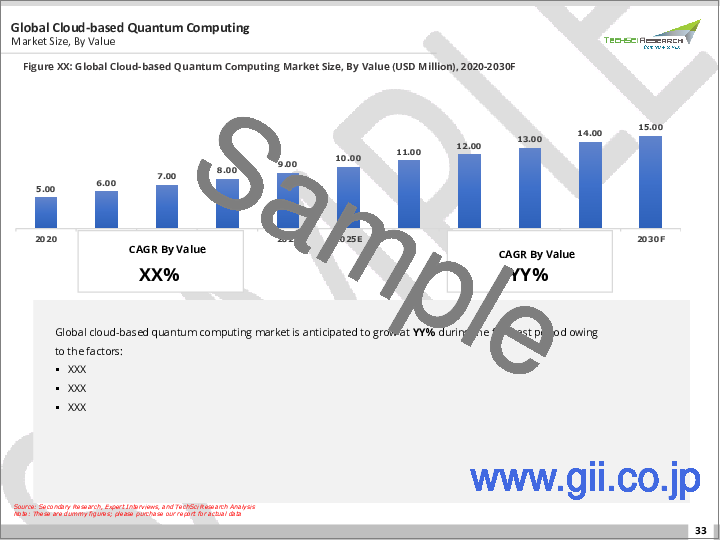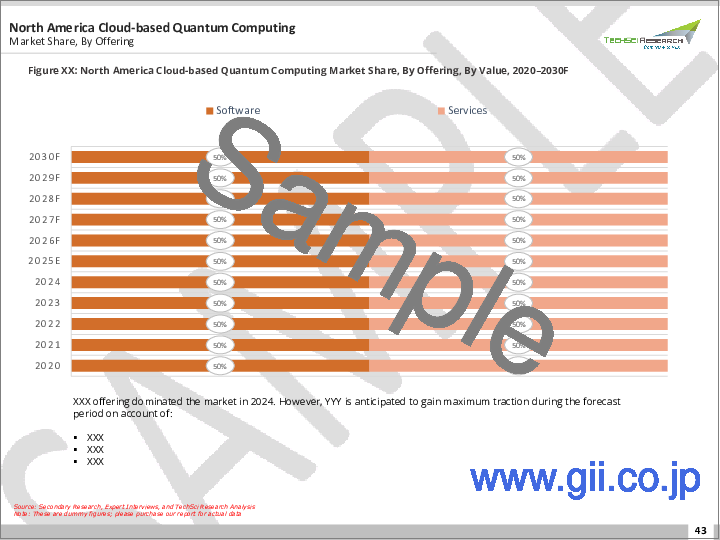|
|
市場調査レポート
商品コード
1770867
クラウドベース量子コンピューティング市場-世界の産業規模、シェア、動向、機会、予測、オファリング別、技術別、用途別、エンドユーザー別、地域別、競合別、2020年~2030年Cloud-based Quantum Computing Market - Global Industry Size, Share, Trends, Opportunity, and Forecast, By Offering, By Technology, By Application, By End User, By Region & Competition, 2020-2030F |
||||||
カスタマイズ可能
|
|||||||
| クラウドベース量子コンピューティング市場-世界の産業規模、シェア、動向、機会、予測、オファリング別、技術別、用途別、エンドユーザー別、地域別、競合別、2020年~2030年 |
|
出版日: 2025年07月14日
発行: TechSci Research
ページ情報: 英文 185 Pages
納期: 2~3営業日
|
全表示
- 概要
- 目次
クラウドベース量子コンピューティングの世界市場は、2024年には7億4,251万米ドルとなり、2030年までには23億6,531万米ドルに達すると予測され、予測期間中のCAGRは21.30%で成長すると予測されています。
クラウドベース量子コンピューティングとは、インターネット経由でアクセス可能なプラットフォームを通じて量子計算機能を提供し、ユーザーが物理的なハードウェアを所有することなく量子プロセッサにリモートアクセスできるようにすることです。バイナリ状態に依存する古典的なコンピューティングとは異なり、量子コンピューティングは複数の状態を同時に存在させることができる量子ビットを活用するため、処理能力が飛躍的に向上します。クラウドデリバリーは、高いインフラコストを排除し、世界中の研究者、開発者、企業がアクセスできるようにすることで、この強力な技術へのアクセスを民主化します。IBM、Amazon、Google、Microsoftなどの大手テクノロジー企業は、量子コンピューティングアプリケーションをサポートするクラウドベースのプラットフォームを開発しています。市場の成長には、製薬、暗号、ロジスティクス、AIなどの業界全体で、非常に複雑な問題を解決する必要性が高まっていることが背景にあり、投資の増加、産学連携、QaaS(quantum-as-a-service)モデルの出現が後押ししています。
| 市場概要 | |
|---|---|
| 予測期間 | 2026年~2030年 |
| 市場規模:2024年 | 7億4,251万米ドル |
| 市場規模:2030年 | 23億6,531万米ドル |
| CAGR:2025年~2030年 | 21.30% |
| 急成長セグメント | シミュレーションとモデリング |
| 最大市場 | 北米 |
主要な市場促進要因
各業界における計算需要の高まり
主要な市場課題
技術の未熟さとハードウェアの限界
主要な市場動向
量子と古典のハイブリッドワークフローの出現
目次
第1章 ソリューションの概要
- 市場の定義
- 市場の範囲
- 対象市場
- 調査対象年
- 主要市場セグメンテーション
第2章 調査手法
第3章 エグゼクティブサマリー
第4章 顧客の声
第5章 世界のクラウドベース量子コンピューティング市場展望
- 市場規模・予測
- 金額別
- 市場シェア・予測
- オファリング別(ソフトウェア、サービス)
- 技術別(トラップイオン、量子アニーリング、超伝導量子ビット、その他)
- アプリケーション別(最適化、シミュレーションとモデリング、サンプリング、その他)
- エンドユーザー別(航空宇宙・防衛、BFSI、ヘルスケア、自動車、エネルギー・電力、化学、政府、その他)
- 地域別(北米、欧州、南米、中東・アフリカ、アジア太平洋)
- 企業別(2024年)
- 市場マップ
第6章 北米のクラウドベース量子コンピューティング市場展望
- 市場規模・予測
- 市場シェア・予測
- 北米:国別分析
- 米国
- カナダ
- メキシコ
第7章 欧州のクラウドベース量子コンピューティング市場展望
- 市場規模・予測
- 市場シェア・予測
- 欧州:国別分析
- ドイツ
- フランス
- 英国
- イタリア
- スペイン
第8章 アジア太平洋のクラウドベース量子コンピューティング市場展望
- 市場規模・予測
- 市場シェア・予測
- アジア太平洋:国別分析
- 中国
- インド
- 日本
- 韓国
- オーストラリア
第9章 中東・アフリカのクラウドベース量子コンピューティング市場展望
- 市場規模・予測
- 市場シェア・予測
- 中東・アフリカ:国別分析
- サウジアラビア
- アラブ首長国連邦
- 南アフリカ
第10章 南米のクラウドベース量子コンピューティング市場展望
- 市場規模・予測
- 市場シェア・予測
- 南米:国別分析
- ブラジル
- コロンビア
- アルゼンチン
第11章 市場力学
- 促進要因
- 課題
第12章 市場動向と発展
- 合併と買収
- 製品上市
- 最近の動向
第13章 企業プロファイル
- IBM Corporation
- Fujitsu Limited
- Atos SE
- IonQ, Inc.
- D-Wave Quantum Inc.
- Amazon.com, Inc.
- Microsoft Corporation
- Alphabet Inc.
第14章 戦略的提言
第15章 調査会社について・免責事項
The Global Cloud-based Quantum Computing Market was valued at USD 742.51 million in 2024 and is projected to reach USD 2365.31 million by 2030, growing at a CAGR of 21.30% during the forecast period. Cloud-based quantum computing refers to the delivery of quantum computational capabilities via internet-accessible platforms, enabling users to access quantum processors remotely without owning the physical hardware. Unlike classical computing, which relies on binary states, quantum computing leverages qubits capable of existing in multiple states simultaneously, thereby offering exponential increases in processing power. Cloud delivery democratizes access to this powerful technology by eliminating high infrastructure costs and making it accessible to researchers, developers, and enterprises worldwide. Leading technology firms including IBM, Amazon, Google, and Microsoft have developed cloud-based platforms that support quantum computing applications. Growth in the market is being fueled by the rising need to solve highly complex problems across industries such as pharmaceuticals, cryptography, logistics, and AI, supported by increased investments, academic-industry collaborations, and the emergence of quantum-as-a-service models.
| Market Overview | |
|---|---|
| Forecast Period | 2026-2030 |
| Market Size 2024 | USD 742.51 Million |
| Market Size 2030 | USD 2365.31 Million |
| CAGR 2025-2030 | 21.30% |
| Fastest Growing Segment | Simulation and Modelling |
| Largest Market | North America |
Key Market Drivers
Rising Computational Demands Across Industries
As organizations across sectors face increasingly intricate data and modeling challenges, the demand for more powerful computational methods is rising sharply. Conventional high-performance computing systems often prove inadequate for processing massive datasets, simulating molecular interactions, or optimizing nonlinear systems. Quantum computing introduces a revolutionary approach by enabling parallel state evaluations via qubits, which significantly enhances computational efficiency. Through cloud platforms, businesses can integrate quantum computing into their existing workflows without the need to invest in costly quantum infrastructure.
Industries such as finance, healthcare, logistics, and automotive are actively leveraging quantum computing for tasks like fraud detection, molecular simulations, and predictive maintenance. For instance, financial firms are using quantum algorithms for complex portfolio optimization, while automotive companies apply quantum techniques to model electric vehicle battery behavior. Cloud access makes these tools readily available, fostering innovation and experimentation across enterprises. Service providers are offering scalable models, APIs, and hybrid environments to meet the growing demand for advanced computation. The U.S. National Institute of Standards and Technology (NIST) notes that quantum systems can solve cryptographic problems in polynomial time, a task that would take classical supercomputers over 100 million years-highlighting the urgency and potential impact of cloud-based quantum adoption.
Key Market Challenges
Technological Immaturity and Hardware Limitations
Despite its transformative potential, cloud-based quantum computing is hindered by the early-stage development of its hardware. Current quantum processors are limited by factors such as low qubit counts, high error rates, and short coherence times, which restrict the execution of stable, reliable computations. Most platforms utilize fragile physical systems-including superconducting circuits, trapped ions, or photonic qubits-that are highly sensitive to environmental conditions like temperature and electromagnetic interference. These limitations require intensive error correction and calibration, which significantly impacts performance consistency.
Quantum error correction remains a major bottleneck, as achieving a single logical qubit may demand hundreds or thousands of physical qubits, adding substantial overhead to already constrained systems. As of now, no cloud-based quantum processor has demonstrated business-relevant quantum supremacy. Consequently, organizations still depend on classical simulators or hybrid models, limiting the scope of quantum benefits. This immaturity leads to hesitancy among enterprises where operational reliability and ROI are critical. Until more scalable, fault-tolerant quantum systems emerge, adoption will likely be restricted to research environments and early exploratory use cases.
Key Market Trends
Emergence of Hybrid Quantum-Classical Workflows
A prominent trend in the Global Cloud-based Quantum Computing Market is the rise of hybrid computing models that combine classical systems with quantum processors. These integrated workflows allow specific problem segments to be addressed using quantum algorithms, while traditional computing handles other components. This dual-processing strategy enhances efficiency and enables near-term applications in areas such as optimization, machine learning, and predictive analytics.
Cloud providers are evolving their platforms to support these hybrid environments, offering tools such as quantum simulators, modular APIs, and orchestration frameworks that allow seamless switching between quantum and classical components. Technology vendors are focusing on interoperability between CPUs, GPUs, and quantum processing units (QPUs) to streamline development cycles and improve usability. This trend is accelerating enterprise experimentation and bridging the gap until quantum hardware becomes mature enough for standalone deployment in commercial scenarios.
Key Market Players
- IBM Corporation
- Fujitsu Limited
- Atos SE
- IonQ, Inc.
- D-Wave Quantum Inc.
- Amazon.com, Inc.
- Microsoft Corporation
- Alphabet Inc.
Report Scope:
In this report, the Global Cloud-based Quantum Computing Market has been segmented into the following categories, in addition to the industry trends which have also been detailed below:
Cloud-based Quantum Computing Market, By Offering:
- Software
- Services
Cloud-based Quantum Computing Market, By Technology:
- Trapped Ions
- Quantum Annealing
- Superconducting Qubits
- Others
Cloud-based Quantum Computing Market, By Application:
- Optimization
- Simulation and Modelling
- Sampling
- Others
Cloud-based Quantum Computing Market, By End User:
- Aerospace & Defense
- BFSI
- Healthcare
- Automotive
- Energy & Power
- Chemical
- Government
- Others
Cloud-based Quantum Computing Market, By Region:
- North America
- United States
- Canada
- Mexico
- Europe
- Germany
- France
- United Kingdom
- Italy
- Spain
- Asia Pacific
- China
- India
- Japan
- South Korea
- Australia
- Middle East & Africa
- Saudi Arabia
- UAE
- South Africa
- South America
- Brazil
- Colombia
- Argentina
Competitive Landscape
Company Profiles: Detailed analysis of the major companies present in the Global Cloud-based Quantum Computing Market.
Available Customizations:
Global Cloud-based Quantum Computing Market report with the given market data, Tech Sci Research offers customizations according to a company's specific needs. The following customization options are available for the report:
Company Information
- Detailed analysis and profiling of additional market players (up to five).
Table of Contents
1. Solution Overview
- 1.1. Market Definition
- 1.2. Scope of the Market
- 1.2.1. Markets Covered
- 1.2.2. Years Considered for Study
- 1.2.3. Key Market Segmentations
2. Research Methodology
- 2.1. Objective of the Study
- 2.2. Baseline Methodology
- 2.3. Key Industry Partners
- 2.4. Major Association and Secondary Sources
- 2.5. Forecasting Methodology
- 2.6. Data Triangulation & Validation
- 2.7. Assumptions and Limitations
3. Executive Summary
- 3.1. Overview of the Market
- 3.2. Overview of Key Market Segmentations
- 3.3. Overview of Key Market Players
- 3.4. Overview of Key Regions/Countries
- 3.5. Overview of Market Drivers, Challenges, and Trends
4. Voice of Customer
5. Global Cloud-based Quantum Computing Market Outlook
- 5.1. Market Size & Forecast
- 5.1.1. By Value
- 5.2. Market Share & Forecast
- 5.2.1. By Offering (Software, Services)
- 5.2.2. By Technology (Trapped Ions, Quantum Annealing, Superconducting Qubits, Others)
- 5.2.3. By Application (Optimization, Simulation and Modelling, Sampling, Others)
- 5.2.4. By End User (Aerospace & Defense, BFSI, Healthcare, Automotive, Energy & Power, Chemical, Government, Others)
- 5.2.5. By Region (North America, Europe, South America, Middle East & Africa, Asia Pacific)
- 5.3. By Company (2024)
- 5.4. Market Map
6. North America Cloud-based Quantum Computing Market Outlook
- 6.1. Market Size & Forecast
- 6.1.1. By Value
- 6.2. Market Share & Forecast
- 6.2.1. By Offering
- 6.2.2. By Technology
- 6.2.3. By Application
- 6.2.4. By End User
- 6.2.5. By Country
- 6.3. North America: Country Analysis
- 6.3.1. United States Cloud-based Quantum Computing Market Outlook
- 6.3.1.1. Market Size & Forecast
- 6.3.1.1.1. By Value
- 6.3.1.2. Market Share & Forecast
- 6.3.1.2.1. By Offering
- 6.3.1.2.2. By Technology
- 6.3.1.2.3. By Application
- 6.3.1.2.4. By End User
- 6.3.1.1. Market Size & Forecast
- 6.3.2. Canada Cloud-based Quantum Computing Market Outlook
- 6.3.2.1. Market Size & Forecast
- 6.3.2.1.1. By Value
- 6.3.2.2. Market Share & Forecast
- 6.3.2.2.1. By Offering
- 6.3.2.2.2. By Technology
- 6.3.2.2.3. By Application
- 6.3.2.2.4. By End User
- 6.3.2.1. Market Size & Forecast
- 6.3.3. Mexico Cloud-based Quantum Computing Market Outlook
- 6.3.3.1. Market Size & Forecast
- 6.3.3.1.1. By Value
- 6.3.3.2. Market Share & Forecast
- 6.3.3.2.1. By Offering
- 6.3.3.2.2. By Technology
- 6.3.3.2.3. By Application
- 6.3.3.2.4. By End User
- 6.3.3.1. Market Size & Forecast
- 6.3.1. United States Cloud-based Quantum Computing Market Outlook
7. Europe Cloud-based Quantum Computing Market Outlook
- 7.1. Market Size & Forecast
- 7.1.1. By Value
- 7.2. Market Share & Forecast
- 7.2.1. By Offering
- 7.2.2. By Technology
- 7.2.3. By Application
- 7.2.4. By End User
- 7.2.5. By Country
- 7.3. Europe: Country Analysis
- 7.3.1. Germany Cloud-based Quantum Computing Market Outlook
- 7.3.1.1. Market Size & Forecast
- 7.3.1.1.1. By Value
- 7.3.1.2. Market Share & Forecast
- 7.3.1.2.1. By Offering
- 7.3.1.2.2. By Technology
- 7.3.1.2.3. By Application
- 7.3.1.2.4. By End User
- 7.3.1.1. Market Size & Forecast
- 7.3.2. France Cloud-based Quantum Computing Market Outlook
- 7.3.2.1. Market Size & Forecast
- 7.3.2.1.1. By Value
- 7.3.2.2. Market Share & Forecast
- 7.3.2.2.1. By Offering
- 7.3.2.2.2. By Technology
- 7.3.2.2.3. By Application
- 7.3.2.2.4. By End User
- 7.3.2.1. Market Size & Forecast
- 7.3.3. United Kingdom Cloud-based Quantum Computing Market Outlook
- 7.3.3.1. Market Size & Forecast
- 7.3.3.1.1. By Value
- 7.3.3.2. Market Share & Forecast
- 7.3.3.2.1. By Offering
- 7.3.3.2.2. By Technology
- 7.3.3.2.3. By Application
- 7.3.3.2.4. By End User
- 7.3.3.1. Market Size & Forecast
- 7.3.4. Italy Cloud-based Quantum Computing Market Outlook
- 7.3.4.1. Market Size & Forecast
- 7.3.4.1.1. By Value
- 7.3.4.2. Market Share & Forecast
- 7.3.4.2.1. By Offering
- 7.3.4.2.2. By Technology
- 7.3.4.2.3. By Application
- 7.3.4.2.4. By End User
- 7.3.4.1. Market Size & Forecast
- 7.3.5. Spain Cloud-based Quantum Computing Market Outlook
- 7.3.5.1. Market Size & Forecast
- 7.3.5.1.1. By Value
- 7.3.5.2. Market Share & Forecast
- 7.3.5.2.1. By Offering
- 7.3.5.2.2. By Technology
- 7.3.5.2.3. By Application
- 7.3.5.2.4. By End User
- 7.3.5.1. Market Size & Forecast
- 7.3.1. Germany Cloud-based Quantum Computing Market Outlook
8. Asia Pacific Cloud-based Quantum Computing Market Outlook
- 8.1. Market Size & Forecast
- 8.1.1. By Value
- 8.2. Market Share & Forecast
- 8.2.1. By Offering
- 8.2.2. By Technology
- 8.2.3. By Application
- 8.2.4. By End User
- 8.2.5. By Country
- 8.3. Asia Pacific: Country Analysis
- 8.3.1. China Cloud-based Quantum Computing Market Outlook
- 8.3.1.1. Market Size & Forecast
- 8.3.1.1.1. By Value
- 8.3.1.2. Market Share & Forecast
- 8.3.1.2.1. By Offering
- 8.3.1.2.2. By Technology
- 8.3.1.2.3. By Application
- 8.3.1.2.4. By End User
- 8.3.1.1. Market Size & Forecast
- 8.3.2. India Cloud-based Quantum Computing Market Outlook
- 8.3.2.1. Market Size & Forecast
- 8.3.2.1.1. By Value
- 8.3.2.2. Market Share & Forecast
- 8.3.2.2.1. By Offering
- 8.3.2.2.2. By Technology
- 8.3.2.2.3. By Application
- 8.3.2.2.4. By End User
- 8.3.2.1. Market Size & Forecast
- 8.3.3. Japan Cloud-based Quantum Computing Market Outlook
- 8.3.3.1. Market Size & Forecast
- 8.3.3.1.1. By Value
- 8.3.3.2. Market Share & Forecast
- 8.3.3.2.1. By Offering
- 8.3.3.2.2. By Technology
- 8.3.3.2.3. By Application
- 8.3.3.2.4. By End User
- 8.3.3.1. Market Size & Forecast
- 8.3.4. South Korea Cloud-based Quantum Computing Market Outlook
- 8.3.4.1. Market Size & Forecast
- 8.3.4.1.1. By Value
- 8.3.4.2. Market Share & Forecast
- 8.3.4.2.1. By Offering
- 8.3.4.2.2. By Technology
- 8.3.4.2.3. By Application
- 8.3.4.2.4. By End User
- 8.3.4.1. Market Size & Forecast
- 8.3.5. Australia Cloud-based Quantum Computing Market Outlook
- 8.3.5.1. Market Size & Forecast
- 8.3.5.1.1. By Value
- 8.3.5.2. Market Share & Forecast
- 8.3.5.2.1. By Offering
- 8.3.5.2.2. By Technology
- 8.3.5.2.3. By Application
- 8.3.5.2.4. By End User
- 8.3.5.1. Market Size & Forecast
- 8.3.1. China Cloud-based Quantum Computing Market Outlook
9. Middle East & Africa Cloud-based Quantum Computing Market Outlook
- 9.1. Market Size & Forecast
- 9.1.1. By Value
- 9.2. Market Share & Forecast
- 9.2.1. By Offering
- 9.2.2. By Technology
- 9.2.3. By Application
- 9.2.4. By End User
- 9.2.5. By Country
- 9.3. Middle East & Africa: Country Analysis
- 9.3.1. Saudi Arabia Cloud-based Quantum Computing Market Outlook
- 9.3.1.1. Market Size & Forecast
- 9.3.1.1.1. By Value
- 9.3.1.2. Market Share & Forecast
- 9.3.1.2.1. By Offering
- 9.3.1.2.2. By Technology
- 9.3.1.2.3. By Application
- 9.3.1.2.4. By End User
- 9.3.1.1. Market Size & Forecast
- 9.3.2. UAE Cloud-based Quantum Computing Market Outlook
- 9.3.2.1. Market Size & Forecast
- 9.3.2.1.1. By Value
- 9.3.2.2. Market Share & Forecast
- 9.3.2.2.1. By Offering
- 9.3.2.2.2. By Technology
- 9.3.2.2.3. By Application
- 9.3.2.2.4. By End User
- 9.3.2.1. Market Size & Forecast
- 9.3.3. South Africa Cloud-based Quantum Computing Market Outlook
- 9.3.3.1. Market Size & Forecast
- 9.3.3.1.1. By Value
- 9.3.3.2. Market Share & Forecast
- 9.3.3.2.1. By Offering
- 9.3.3.2.2. By Technology
- 9.3.3.2.3. By Application
- 9.3.3.2.4. By End User
- 9.3.3.1. Market Size & Forecast
- 9.3.1. Saudi Arabia Cloud-based Quantum Computing Market Outlook
10. South America Cloud-based Quantum Computing Market Outlook
- 10.1. Market Size & Forecast
- 10.1.1. By Value
- 10.2. Market Share & Forecast
- 10.2.1. By Offering
- 10.2.2. By Technology
- 10.2.3. By Application
- 10.2.4. By End User
- 10.2.5. By Country
- 10.3. South America: Country Analysis
- 10.3.1. Brazil Cloud-based Quantum Computing Market Outlook
- 10.3.1.1. Market Size & Forecast
- 10.3.1.1.1. By Value
- 10.3.1.2. Market Share & Forecast
- 10.3.1.2.1. By Offering
- 10.3.1.2.2. By Technology
- 10.3.1.2.3. By Application
- 10.3.1.2.4. By End User
- 10.3.1.1. Market Size & Forecast
- 10.3.2. Colombia Cloud-based Quantum Computing Market Outlook
- 10.3.2.1. Market Size & Forecast
- 10.3.2.1.1. By Value
- 10.3.2.2. Market Share & Forecast
- 10.3.2.2.1. By Offering
- 10.3.2.2.2. By Technology
- 10.3.2.2.3. By Application
- 10.3.2.2.4. By End User
- 10.3.2.1. Market Size & Forecast
- 10.3.3. Argentina Cloud-based Quantum Computing Market Outlook
- 10.3.3.1. Market Size & Forecast
- 10.3.3.1.1. By Value
- 10.3.3.2. Market Share & Forecast
- 10.3.3.2.1. By Offering
- 10.3.3.2.2. By Technology
- 10.3.3.2.3. By Application
- 10.3.3.2.4. By End User
- 10.3.3.1. Market Size & Forecast
- 10.3.1. Brazil Cloud-based Quantum Computing Market Outlook
11. Market Dynamics
- 11.1. Drivers
- 11.2. Challenges
12. Market Trends and Developments
- 12.1. Merger & Acquisition (If Any)
- 12.2. Product Launches (If Any)
- 12.3. Recent Developments
13. Company Profiles
- 13.1. IBM Corporation
- 13.1.1. Business Overview
- 13.1.2. Key Revenue and Financials
- 13.1.3. Recent Developments
- 13.1.4. Key Personnel
- 13.1.5. Key Product/Services Offered
- 13.2. Fujitsu Limited
- 13.3. Atos SE
- 13.4. IonQ, Inc.
- 13.5. D-Wave Quantum Inc.
- 13.6. Amazon.com, Inc.
- 13.7. Microsoft Corporation
- 13.8. Alphabet Inc.





